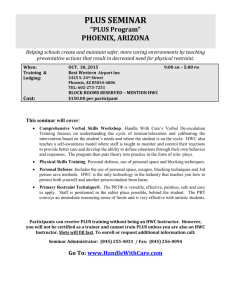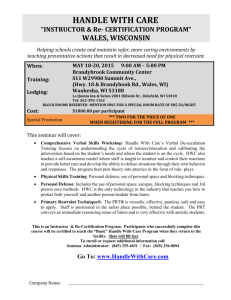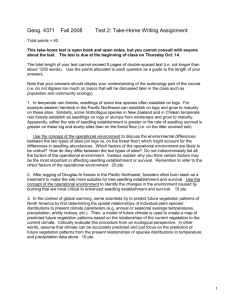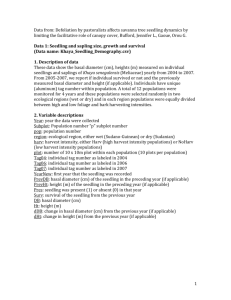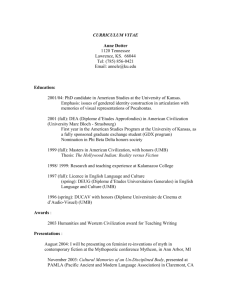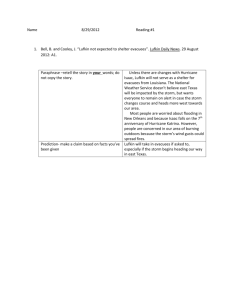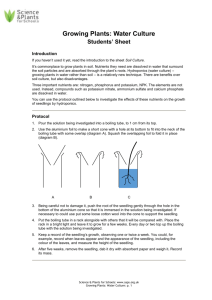herbaceous weed control on newly planted pine stands with oustar
advertisement
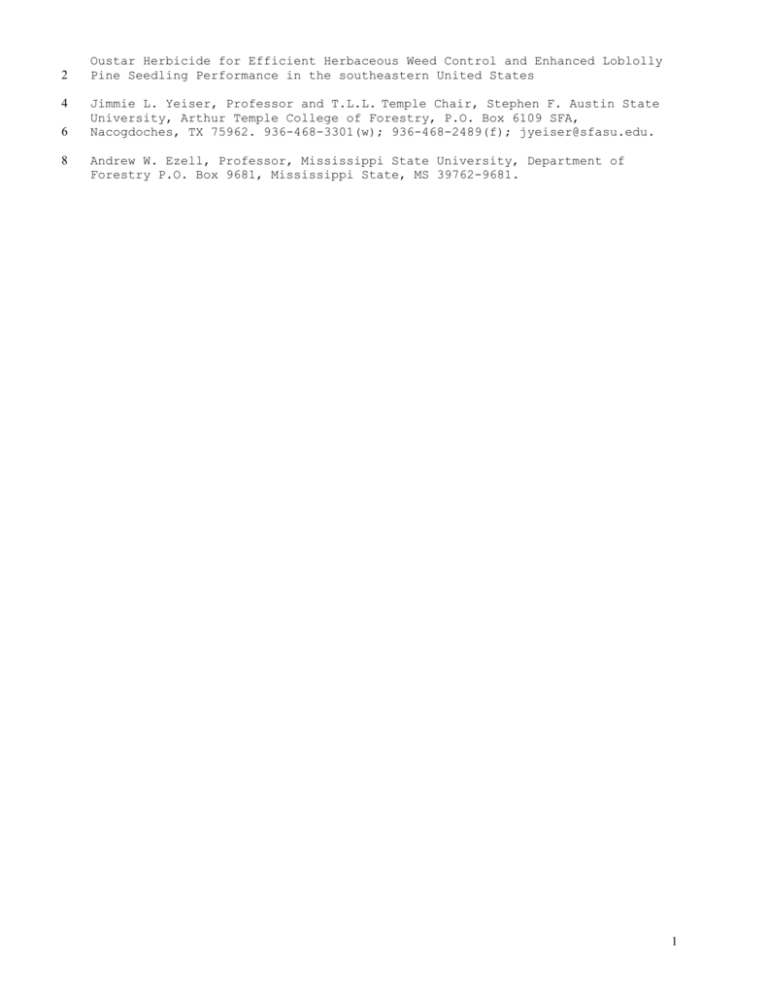
2 4 6 8 Oustar Herbicide for Efficient Herbaceous Weed Control and Enhanced Loblolly Pine Seedling Performance in the southeastern United States Jimmie L. Yeiser, Professor and T.L.L. Temple Chair, Stephen F. Austin State University, Arthur Temple College of Forestry, P.O. Box 6109 SFA, Nacogdoches, TX 75962. 936-468-3301(w); 936-468-2489(f); jyeiser@sfasu.edu. Andrew W. Ezell, Professor, Mississippi State University, Department of Forestry P.O. Box 9681, Mississippi State, MS 39762-9681. 1 Abstract 2 4 6 8 10 12 14 16 18 20 22 24 26 28 Oustar herbicide is a new pre-mixed blend of hexazinone (Velpar DF)+sulfometuron (Oust XP). Tests at six sites in the southeastern United States were established to compare Oustar (0, 10, 13, 16, 19 oz product ac-1) to industry standards (Velpar L+Oust 32+2; Arsenal AC+Oust 4+2, both in oz product ac-1) for herbaceous weed control (HWC) and resultant loblolly pine (Pinus taeda L.) seedling performance. Sites were prepared prior to planting with: fire only, chemical followed by a burn, mechanical only, or chemical and mechanical methods. Oustar (13 oz) and industry standards provided similar HWC and seedling performance. When averaged across all six sites, herbicide plots consistently had more bareground than untreated plots by nearly 2X at 30 days after treatment (DAT), 3X at 60-DAT, 4X at 90-DAT, and 5X at 120-DAT. Similarly, herbicide treatments increased age-two seedling survival (9%), total height (0.69 ft), ground line diameter (0.26 in), and volume index (1.54x10-2 ft3) over that of untreated seedlings. Late (October) site preparation commonly resulted in less herbaceous cover on application day. Sites with less ground cover on application day exhibited more bareground at 60- and 120-DAT than sites with high initial ground cover. The low rate (10 oz) of Oustar applied to sandy loam soils receiving chemical and mechanical preparation prior to planting provided bareground comparable to industry standards. Managers integrating late site preparation followed by spring HWC may achieve customary levels of HWC for more of the growing season with less herbicide than industry standards. Site preparation by HWC interactions reported for loblolly pine may have broader applications to coniferous plantation establishment. More research is needed to define additional site preparation by HWC interactions and their usefulness in coniferous plantation establishment. No adverse herbicide effects were seen on any crop trees. 30 32 Author Keywords: Herbaceous control, herbaceous weed control, vegetation management, pine management, Oustar, Oust, Velpar, Arsenal, Pinus taeda, loblolly pine 34 2 Introduction 2 4 6 8 10 12 14 16 18 20 22 24 26 28 30 32 34 36 Historically, forest managers in the southeastern United States have been concerned about the negative impact of herbaceous competition on loblolly pine seedling performance. Since the 1970s, numerous studies have addressed relationships between herbaceous weeds and loblolly pine seedling survival and growth (Holt et al., 1975 and Creighton et al., 1987). Herbaceous weeds are known to compete with newly planted loblolly pine seedlings for water, nutrients, light, and space (Nelson et al., 1981, Tiarks and Haywood, 1986 and Zutter et al., 1986). When compared to plantings without herbaceous weed control (HWC), treated loblolly pine plantations are commonly characterized by increased planting survival that persists into midrotation (Clason, 1987), enhanced growth (Glover et al., 1989), early commercial thinning (Glover et al., 1989), and shorter rotations (Clason, 1989 and Glover et al., 1989). Therefore, HWC is a commonly accepted practice in loblolly pine plantation management in the southeastern United States. Velpar L (hexazinone) and Oust (sulfometuron) are forest herbicides manufactured by E.I. du Pont de Nemours and Company. These products were packaged, sold, stored, and handled separately in early research (Fitzgerald, 1976 and Creighton et al., 1987) and operational trials for pine release. Managers now realize Velpar L and Oust mixtures offer economical (Dangerfield and Merck, 1990 and Miller et al., 1994), broad-spectrum control (Zutter et al., 1987) with excellent pine tolerance for enhanced seedling performance. Consequently, a tank mixture of Velpar L and Oust is an industry standard for HWC (Muir and Zutter, 1998 and Muir and Zutter, 1999). Each gallon of Velpar L contains 25% hexazinone, plus alcohol and other ingredients for stability and shelf life. Because of the alcohol, Velpar L is more flammable than other forest herbicides. Oust herbicide was a granule containing 75% sulfometuron. The product was pan granulated with chemical binders that hold the dust-like particles together. When added to water, Oust formed a suspension and if allowed to sit, Oust settled to the tank bottom. There, the same binders used to hold the dry particles together turn the Oust-particles into a paste. Good agitation prior to spraying was required for re-suspension. 38 40 42 44 New extruded granular formulations of Oust and Velpar were tested in 1999 (Wood and Yeiser, 2000). Extruded granules lack the chemical binders previously used for pan granules. Consequently, the new formulation of Oust, Oust XP, has improved solubility. If allowed to settle, Oust XP requires less agitation than the original Oust for re-suspension. Compared to Velpar L, the new formulation, Velpar DF (dry flowable), is alcohol free and 75% concentrated. 46 48 50 52 54 56 58 Oustar, developed for testing in 2000, is a pre-mixed blend of Oust XP (11.5% sulfometuron) and Velpar DF (63.2% hexazinone). It brings the enhanced properties of the new formulations into one container for increased convenience of storage, handling, and mixing. Furthermore, the new granules of Oust XP and Velpar DF are identical in size, shape, and density to prevent segregation during handling and transportation. Oustar (13 oz) contains the same amount of active ingredients as the standard tank mix of Velpar L+Oust (32+2 oz) and is of particular interest to managers. The objective of this project was to compare use rates of Oustar to conventional industry standards (Velpar L+Oust 32+2; Arsenal AC+Oust 4+2, both in oz product ac-1) for HWC and enhanced survival and growth of loblolly pine seedlings. 60 Materials and methods 3 2 Study sites 4 Field trials were established in March 2000 at six sites: in Cold Point, SC; Diboll and Lufkin, TX; Picayune, MS; Starkville, MS; and Whitfield, AL (Figure 1). The sites were selected to vary in preparation intensity and timing (Table 1). A wildfire at Lufkin is an example of low intensity preparation. Chemical and mechanical treatments at Diboll and Cold Point exemplify high intensity preparation. Shear, rake, and windrow at Whitfield in July is considered early preparation and the same methods in October at Picayune is considered late preparation. Cold Point, Picayune, and Starkville were hand planted in January and Lufkin in February with bare root seedlings. Whitfield was machine planted with bare root seedlings while Diboll was hand planted with containerized seedlings both in January. All sites were planted in 2000. 6 8 10 12 14 16 Study treatments 18 26 Herbicide treatments were applied pre-emergence at Cold Point, Diboll, Picayune, and Starkville , and post-emergence at Lufkin and Whitfield (Table 1). Herbicide treatments were: (1) Oustar 10 oz, (2) Oustar 13 oz, (3) Oustar 16 oz, (4) Oustar 19 oz, (5) Velpar L+Oust 32+2 oz, (6) Arsenal AC+Oust 4+2 oz, and (7) untreated check. All rates are presented in ounces of product per treated acre. Herbicides were applied in 5-ft bands centered over the top of seedling rows. Total volume of herbicide mix was 10 gallons per acre. 28 Study plots 30 Treatment plots in Diboll, Lufkin, and Starkville contained 16 seedlings in a single row. Measurement plots, inside treatment plots, contained 12 seedlings with 2 buffer seedlings on each end. In Cold Point, Picayune, and Whitfield, treatment and measurement plots contained 10 seedlings. 20 22 24 32 34 40 Treatments were visually evaluated for percent bareground prior to herbicide application and at 30, 60, 90, and 120 DAT (Miller and Glover, 1991). Seedlings were assessed for survival (%) and measured for height (HT, ft) and ground line diameter (GLD, in) prior to treatment and after one and two growing seasons. Volume index (VI) was computed as VI=HT X GLD2 and expressed in ft3. Year-one ground cover and year-two seedling growth are presented. 42 Data analysis 44 48 Each test site had four blocks. Treatments were assigned in a randomized complete block design. Treatment effects were partitioned by an analysis of variance with means separated using Duncan’s New Multiple Range Test (α=0.05). All percent data were arcsine-square root transformed prior to analysis. 50 Results and discussion 52 Overall mean bareground Overall bareground (weed free) treatment means were computed across all six sites and presented for each evaluation date (Table 2). At 30-DAT, all herbicide test treatments were similarly weed free. At 60-DAT, bareground on plots receiving 10 oz of Oustar was less than for higher Oustar rates, but similar to industry standards. At 90-DAT, all herbicide treatments provided very similar HWC with statistical differences detected among the highest (84%) and lowest (76%) levels of bareground. At 120-DAT, bareground was similar for all herbicide treatments. 36 38 46 54 56 58 60 4 2 4 6 8 10 12 14 16 18 20 As the growing season progressed, the overall bareground means for 30through 120-DAT varied little between Oustar use rates (Table 2). For example, bareground at 30-DAT ranged only 5% from a low of 91 to a high of 96%. At 60-DAT, bareground ranged 8% from a low of 84 to a high of 92%. At 90-DAT, bareground ranged 8%, from a low of 76 to a high of 84%. At 120-DAT, bareground ranged 8% from a low of 61 to a high of 69%. For all evaluation dates, industry standards consistently provided weed-free growing space intermediate between the low and high Oustar test rates. Therefore, several Oustar rates provided HWC comparable to industry standards, allowing managers to increase or decrease rates as management intensity and budgets dictate. For all rates and sites, no adverse herbicide effects were seen on any crop trees. Herbicide treated plots were consistently more weed free than untreated checks. In fact, the mean bareground of all herbaceous weed treatments compared with the untreated check at 30-, 60-, 90-, and 120-DAT was 93 and 46; 89 and 32; 80 and 22; and 66 and 12%, respectively. This is nearly 2X at 30-DAT, 3X at 60-DAT, 4X at 90-DAT, and 5X at 120-DAT more bareground on treated than untreated plots. The patterns in HWC reported here for Oustar (13 oz) are similar to those for Velpar L+Oust (32+2 oz) here and reported by other users (Muir and Zutter, 1999 and Earl and Williams, 2001). 22 Bareground by site 24 26 28 Mean percent bareground varied by site (Table 2). Weed-free conditions were highest at Picayune (89%) and Diboll (86%). Bareground at Lufkin (71%) was intermediate and similar to that at Cold Point (69%) and Starkville (68%). Bareground was lowest at Whitfield (64%) but similar to that at Cold Point and Starkville. For all evaluations, sites averaged at least 64% bareground. 30 Bareground by DAT by site 32 34 36 38 40 42 The DAT by site bareground means show herbicides promptly provided weed-free space for seedlings (Table 2). For example, at 60-DAT, percent bareground was statistically Picayune>Diboll>Cold Point=Starkville=Whitfield=Lufkin and numerically 93%, 87%, 78%, 76%, 76%, and 75%, respectively. At 120 days, bareground was statistically Diboll=Picayune>Lufkin=Starkville=Cold Point>Whitfield and numerically 81%, 77%, 55%, 51%, 49%, and 32%, respectively. Picayune and Diboll sites on application day had the lowest ground cover at less than 1% (Table 1). Whitfield on application day had the highest ground cover at almost 80%. Sites with less ground cover on application day generally exhibited more bareground at 60- and 120-DAT than sites with more initial ground cover. 44 46 48 50 52 54 The DAT by site means illustrate the duration of HWC (Table 2). For example, at Cold Point, bareground peaked 30-DAT (85%) and troughed 120-DAT at 49%, a decline in HWC of 36%. During this same period, Diboll was 88 and 81% (7% decline), Lufkin 86 and 55% (31% decline), Picayune was 97 and 77% (20% decline), Starkville 84 and 51% (33% decline), and Whitfield 81 and 32% (49% decline). Weed establishment early in the growing season was inhibited by HWC treatments, allowing seedlings to utilize conditions favorable for pine seedling growth. As herbicides degraded, weeds commonly recolonized plots during summer months when conditions were less than optimal for pine seedling growth. Speed of weed recolonization varied at each site by the herbicide use rate and the specific tolerance of the invading herb. 56 58 60 The DAT by site by herbicide means provide four points for consideration (Table 2). First, high rates of Oustar (16 oz, 19 oz) commonly provided best and similar broad-spectrum HWC across all evaluations and sites. An exception was at Starkville were bareground for Oustar (19 oz) at 120-DAT was statistically similar to several test treatments and statistically less by 5 2 4 6 8 16% than Arsenal AC+Oust (4+2 oz). Normally, high rates provide more bareground with longer persistence than lower rates. The low value for Oustar (19 oz) at Starkville can be explained. Certain Oustar (13 oz, 19 oz) treatments were coincidentally colonized by blue vervain (Verbena brasiliensis Vell.) more than plots treated with other rates. Blue vervain is tolerant of sulfometuron and hexazinone, the active ingredients in Oustar (DuPont 2002, 2003). Another example was at Whitfield where Oustar 19 oz provided less HWC than 13 oz. This too resulted from the presence of Oustar tolerant, Rubus. 10 12 14 16 18 20 22 24 26 28 30 32 34 Second, HWC among average use rates of all Oustar treatments, Oustar 13 oz, and the average of industry standards was similar at Cold Point, Diboll, and Picayune. For example, at Cold Point the average of all Oustar treatments, Oustar (13 oz), and the average of industry standards was 90, 89, and 84% bareground, respectively, at 30-DAT; 84, 87, and 82% bareground, respectively, at 60-DAT; 70, 67, and 63% bareground, respectively, at 90-DAT; and 56, 48, and 48% bareground, respectively, at 120-DAT. These data illustrate the highly similar HWC achieved with all Oustar treatments as well as Oustar (13 oz) and industry standards. In contrast, unexpected patterns in herbicide performance at Lufkin, Starkville, and Whitfield may be explained by site preparation method and timing, and species composition of weed recolonization. For example, in Lufkin where the site was prepared by a wildfire, only high rates of Oustar (16 oz, 19 oz) sustained best HWC through 120-DAT. Low rates of Oustar and industry standards performed well early but gradually succumbed to weed pressure. Lufkin was the only test site where one of two industry standards was not among the best treatments tested. This illustrates that when site preparation is meager (wildfire) or fails, higher than customary HWC rates may be required to control established vegetation. At Starkville, plots treated with Oustar (13 oz, 19 oz) were coincidentally colonized by herbicide-tolerant blue vervain more than plots treated with other herbicides. At Whitfield, mechanical preparation in July left ample time for autumn weed seed dissemination on plots. This was evident on application day the following April, when weeds nearly 1-ft tall occupied approximately 80% of the site. Heavy weed levels present on application day were followed by the most aggressive weed recolonization of plots 120-DAT. 36 46 Third, plots treated with Oustar (10 oz) and industry standards were similarly weed free at Cold Point, Diboll and Starkville. At Cold Point and Diboll, low and high rates of Oustar as well as both industry standards provided prompt and sustained control of competition. At Starkville, blue vervain in some Oustar (13 oz and 19 oz) plots contributed to the decline of HWC otherwise comparable to industry standards. Factors likely contributing to the excellent HWC at Cold Point, Diboll, Starkville, and Picayune are early April applications to predominately bareground and low levels of emerging weeds (Table 1). Factors likely influencing competitor levels include the interaction of timing and methods of site preparation. 48 Seedling performance 50 Mean overall seedling performance Seedling performance after two growing seasons was averaged across all six sites (Table 3). As computed from mean values in Table 3, herbicide released seedlings averaged 86.0% survival, 5.2 ft HT, 1.43 in. GLD, and 5.70x10-2 ft3 VI. These seedling values are similar to that reported previously (Miller et al., 1986). On average, HWC increased survival (7.2%), HT (0.47 ft), GLD (0.22 in), and VI (1.22x10-2 ft3) as compared to untreated checks. In a threeway comparison of seedling means for all rates of Oustar, industry standards, or nothing (untreated checks), survival was 85.4, 87.1, and 78.7%; HT 5.1, 5.4, and 4.7 ft; GLD 1.41, 1.48, 1.21 in; and VI 5.48x10-2, 6.16x10-2, and 4.48x10-2 ft3, respectively. Thus, seedling performance was similar for Oustar 38 40 42 44 52 54 56 58 60 6 2 4 6 8 10 12 14 treatments and industry standards and both significantly better than untreated checks. Seedling performance by site Seedling performance varied by site (Table 3). For example, survival was statistically Picayune=Whitfield=Diboll>Starkville>Cold Point>Lufkin and numerically 98.8%, 98.2%, 96.7%, 85.1%, 72.8%, and 65.5%, respectively. Total height, statistically, was Whitfield>Picayune>Starkville>Diboll>Lufkin>Cold Point and numerically 6.8 ft, 6.4 ft, 5.5 ft, 4.9 ft, 4.2 ft, and 2.3 ft, respectively. Ground line diameter, statistically, was Picayune>Whitfield=Diboll>Lufkin>Starkville>Cold Point and numerically 1.76 in, 1.65 in, 1.58 in, 1.35 in, 1.26 in, and 0.51 in, respectively. Volume index, statistically, was Whitfield=Picayune>Diboll=Starkville>Lufkin>Cold Point and numerically, 8.12x10-2 ft3, 8.0x10-2 ft3, 5.79x10-2 ft3, 5.26x10-2 ft3, 4.19x10-2 ft3 and 0.93x10-2 ft3, respectively. 16 18 20 22 Herbicide treatments commonly increased seedling survival and growth over untreated checks. In a comparison of treated versus untreated, performance was significantly enhanced for: survival at three of six sites-Cold Point, Lufkin, and Picayune; HT at three of six sites-Lufkin, Starkville, Whitfield, and overall; GLD at five of six sites-Diboll, Lufkin, Picayune, Starkville, Whitfield, and overall; and VI at five of six sites-Diboll, Lufkin, Picayune, Starkville, Whitfield, and overall. 24 26 28 30 32 34 In a two-way comparison of Oustar (13 oz) and Velpar L+Oust (32+2 oz) across five sites and three seedling growth parameters, Oustar provided statistically similar, greater, or less growth 11, 0, and 4 times, respectively. In a two-way comparison of Oustar (13 oz) and Arsenal AC+Oust (4+2 oz) across five sites and three seedling growth parameters, Oustar provided statistically similar, greater, or less growth 12, 0, and 3 times, respectively. Starkville was not included in these analyses because of the invasion of blue vervain in the Oustar (13 oz, 19 oz) treatments. Results show seedling performances for Oustar (13 oz) and industry standards were very similar. Thus, managers can use Oustar (13 oz) and anticipate seedling growth comparable to Velpar L+Oust (32+2 oz) or Arsenal AC+Oust (4+2 oz). 36 42 Growth means (Table 3) did not closely parallel the site preparation by HWC patterns observed in the DAT by site by herbicide means (Table 2). Climate probably impacted seedling performance. For example, the Texas sites were planted in early 2000 during a major fall-winter drought that probably influenced initial growth. Normal spring rainfall occurred prior to a major summer-fall drought for all sites during the test year, 2000. 44 Conclusions 46 Several use rates of Oustar, including Oustar 13 oz, and industry standards provided comparable HWC and loblolly pine seedling performance at six test sites in the southeastern United States. Results show the potential of Oustar for safe HWC and enhanced loblolly pine seedling survival and growth for a variety of site conditions and preparation methods common to southern pine management. Interactions between timing of site preparation and HWC treatments were detected. Timing and method of site preparation followed by HWC with Oustar can be integrated to achieve more efficient and cost effective total vegetation management. Additional research is needed to define more site preparation and HWC interactions and illustrate their usefulness in coniferous plantation establishment. 38 40 48 50 52 54 56 58 7 References 2 4 6 Clason, T.R.,1987. Effects of competing vegetation on loblolly pine plantations. LA Agric. 31(1),7-9. Clason, T.R.,1989. Early growth enhancement increases loblolly pine rotation yields. South. J. Appl. For. 13(2),94-99. 8 10 Creighton, J.L., Zutter, B.R., Glover, G.R., Gjerstad, D.H.,1987. Planted pine growth and survival responses to herbaceous vegetation control, treatment duration, and herbicide application technique. South. J. Appl. For. 11(4),223-227. 12 14 16 18 Dangerfield, C.W., Jr., Merck, H.L.,1990. Helping pines earn more with weed control. USDA Forest Service South. Region Tech. Paper 14, 23p. DuPont,2002. DuPont Oust XP herbicide. E.I. du Pont de Nemours and Company. Wilmington, DE. 11p. DuPont,2003. DuPont Velpar L herbicide. E.I. du Pont de Nemours and Company. Wilmington, DE. 19p. 20 22 24 Earl, J.A., Williams, R.A.,2001. Comparing rate ranges of Oustar herbicide with industry standards. Proc. South. Weed Sci. Soc. 54:162-165. Fitzgerald, C.H.,1976. Post-emergence effects of Velpar in a piedmont pine plantation. Proc. South. Weed Sci. Soc. Amer. 29:299. 26 28 30 Glover, G.R., Creighton, J.L., Gjerstad, D.H.,1989. Herbaceous weed control increases loblolly pine growth. J. For. 87(2),47-50. Holt, H.A., Voeller, J.E., Young, J.F.,1975. Herbaceous vegetation control as a forest management practice. Proc. South. Weed Sci. Soc. 28:219. 32 34 36 38 40 Miller,J.M., Glover,G.R., eds.,1991. Standard methods for forest herbicide research. Champaign, IL. Southern Weed Science Society. 68p. Miller, J.H., Zutter,B., Zedaker, S.M., Cain, M., Edwards, M.B., Xydias, G.K., Applegate, A.R., Atkins, R.L., Campbell, S., Daly, E., Hollis, C., Knowe, S.A., Paschke, J., 1986. A region-wide study of loblolly pine seedling growth relative to four competition levels after two growing seasons. In: Phillips, D.R., (Ed.), Proc. Fourth Bienn. South. Silvi. Res. Conf. USDA For. Serv. Southeast. For. Exp. Stat. Gen. Tech. Rep. SE-42, pp. 581-591. 42 44 46 Miller, J.H., Busby, R.L., Zutter, B.R., Zedaker, S.M., Edwards, M.B., Newbold, R.A., 1994. Response of loblolly pine to complete woody and herbaceous control: projected yields and economic outcomes-the COMPROJECT. In: Edwards, M.B. (Comp.) Proc. Eighth Bienn. South. Silvi. Res. Conf. USDA For. Serv. South. Res. Stat. Gen. Tech. Rep. SRS1, pp. 81-89. 48 50 Muir, R.L., Jr., Zutter, B.R.,1998. Screening of imazapic, imazethapyr, and imazaquin for herbaceous weed control in loblolly and slash pine plantations-first year results. Auburn University Silvicultural Herbicide Cooperative Res. Note No 98-5, 10p. 52 54 56 58 60 62 Muir, R.L., Jr. and Zutter, B.R.,1999. Pre-emergent herbaceous weed control screenings in loblolly pine (Pinus taeda) plantations in the Coastal Plain and Piedmont: firstyear results. Auburn University Silvicultural Herbicide Cooperative Res. Note No 99-7, 17p. Nelson, L.R., Pedersen, R.C., Autry, L.L., Dudley, S., Walstad, J.D.,1981. Impacts of herbaceous weeds in young loblolly pine plantations. South. J. Appl. For. 5(3),153158. Tiarks, A.E., Haywood, J.D.,1986. Pinus taeda L. response to fertilization, herbaceous plant control, and woody plant control. For. Ecol. Manage. 14,103-112. 64 66 Wood, R., Yeiser, J.L.,2000. Herbaceous weed control and resultant pine seedling growth with new Oust, Velpar, and Escort formulations: year two results. Proc. South. Weed Sci. Soc. 54:109-113. 68 8 2 4 6 Zutter, B.R., Glover, G.R., Gjerstad, D.H.,1986. Effects of herbaceous weed control using herbicides on a young loblolly pine plantation. For. Sci. 32,882-899. Zutter, B.R., Glover, G.R., Gjerstad, D.H.,1987. Vegetation response to intensity of herbaceous weed control in a newly planted loblolly pine plantation. New Forests 4,257-271. 9 2 4 6 8 10 Figure 1. The southeastern United States showing the six test sites comparing different use rates of Oustar to Velpar L+Oust (32+2 oz) and Arsenal AC+Oust (4+2 oz). 12 10 11 2 4 Table 1. A summarized description of the six test sites in the southeastern United States. Site Cold Point, SC Diboll,TX Lufkin, TX Picayune, MS Starkville, MS Established 2000 2000 2000 2000 2000 Physiography Soil 6 8 Harvested Site Prep1 10 Site Prep2 12 14 Treated Percent Cover 16 Major Forbs 18 20 Major Grasses 22 * Piedmont sandy loam pH 5.4 Jul 98 May 99 Chopper+oil 48 oz+5 qt Dec 99 combination plow 13 Apr 00 90% bare <10% @ 6” pre-emergence Ambrosia spp Rubus spp * hilly UCP sandy loam pH 5.4 Sep 98 Sep 99 Arsenal+Garlon 4 16 oz+2 qt Oct 99 combination plow 14 Apr 00 99% bare <1% @ 6” pre-emergence Eupatorium spp Erechtites spp Croton spp Panicum spp Dicanthelium spp Andropogon spp - hilly UCP sandy loam pH 5.0 May 99 Aug 99 wildfire 15 Apr 00 70% bare <40% @ 6” post-emergence Eupatorium spp Conyza spp Panicum spp Dicanthelium spp Andropogon spp * flatwoods LCP silt loam pH 4.2 Dec 98 Oct 99 shear, rake, windrow 48 oz+4 qt Dec 99 burned windrows 5 Apr 00 99% bare <1% @ 6” pre-emergence Eupatorium spp Rubus spp Panicum spp - hilly UCP sandy clay loam pH 4.2 May 99 Aug 99 Chopper+Accord SP Oct 99 burned 10 Apr 00 90% bare <10% @ 6” pre-emergence Eupatorium spp Conyza spp Panicum spp Dicanthelium spp Andropogon spp Whitfield, AL 2000 interior flatwoods LCP sandy loam pH 4.2 Dec 98 Jul 99 shear, rake, windrow 6 Apr 00 20% bare <80% @ 6” post-emergence Eupatorium spp Erechtites spp Ambrosia spp Panicum spp Dicanthelium spp - LCP=lower coastal plain; UCP=upper coastal plain. 12 2 Table 2. Mean bareground (%) 30 through 120 days after treatment (DAT) with Oustar and industry standards (Velpar L+Oust (V+O); Arsenal AC+Oust (A+O)) for herbaceous weed control at six loblolly pine sites in the southeastern United States. 4 Site DAT 6 8 10 12 14 16 18 20 22 24 26 28 30 32 34 36 38 40 42 44 30 60 90 120 Cold Point, SC 30 60 90 120 Diboll, TX 30 60 90 120 Lufkin, TX 30 60 90 120 Picayune, MS 30 60 90 120 Starkville, MS 30 60 90 120 Whitfield, AL 30 60 90 120 * A+O DAT by 13 16 19 * 32+2 91a 84b 76b 61a 94a 90a 81ab 65a 95a 92a 84a 65a 96a 90a 80ab 69a 93a 89ab 81ab 67a 91a 88ab 79ab 66a 46b 32c 22c 12b 85a 81a 76a 53a 89a 87a 67a 48ab 91a 83a 65a 55a 94a 85a 73a 66a 82a 77a 64a 48ab 86a 87a 62a 48ab 65b 44b 31b 26b 85bc 78c 62b 49b 93a 94a 90a 92a 99a 97a 96a 92a 99a 98a 96a 72a 100a 99a 99a 99a 99a 97a 97a 97a 99a 99a 99a 96a 28b 28b 28b 18b 88b 87b 86a 81a 93a 78b 68c 53c 99a 85b 75b 60b 99a 93a 83a 71a 100a 94a 84a 74a 99a 85b 75b 64b 99a 84b 74b 60b 13b 6d 2d 2d 86bc 75c 66b 55b 95ab 92a 90a 75b 98a 96a 96a 89ab 97a 96a 95a 95a 99a 96a 97a 94a 98a 98a 98a 92a 99a 97a 95a 84ab 92b 75b 51b 12c 97a 93a 89a 77a 92a 87a 70ab 63ab 90a 86a 57b 48b 91a 87a 68ab 62ab 90a 84a 67ab 52b 91a 89a 75ab 62ab 93a 83a 80a 68a 37b 17b 5c 5c 84bc 76c 60b 51b 88ab 73c 59c 29b 88ab 91ab 89ab 47a 93a 97a 96a 38ab 95a 81bc 60c 29b 91a 91ab 77abc 39ab 73b 79bc 68bc 38ab 41c 18d 14d 9c 81c 76c 66b 32c 10 * 4+2 Check Site † Mean Site Mean †† ¤ 69bc 86a 71b 89a 68bc 64c Ounces of product per acre. Site by DAT means within a column sharing the same letter are not significantly different (Duncan’s New Multiple Range Test (α=0.05). †† 48 V+O Overall Mean † 46 Oustar Site means within a column sharing the same letter are not significantly different (Duncan’s New Multiple Range Test (α=0.05). ¤ 50 Site by treatment means within a row sharing the same letter are not significantly different (Duncan’s New Multiple Range Test (α=0.05). 13 2 4 Table 3. Seedling survival (%), total height (ft), ground line diameter (GLD, in), and volume index (VI, ft3) two growing seasons following treatment at six sites in the southeastern United States with Oustar or industry standards (Velpar L+Oust (V+O); Arsenal AC+Oust (A+O). Site Oustar V+O A+O Site 6 Parameter 10 13 16 19 8 Overall Means Survival† 86.8a 84.5ab 85.0ab 85.4ab 18 20 22 24 26 28 30 32 34 36 38 40 42 44 46 48 50 85.4ab 4+2 * 88.7a Check Mean †† 78.7b 5.0bc 4.9cd 5.2ab 5.1bc GLD† 1.33d 1.39cd 1.51a 1.40bcd 1.47abc 1.49ab 1.21e VI (x10-2) † 5.11b 5.15b 6.06a 5.59ab Cold Point, SC Survival Total Height GLD VI (x10-2) 87.5a 2.8a .58a 1.24a 75.0a 2.6ab .58a 1.18a Diboll, TX Survival Total Height GLD VI (x10-2) 97.9a 4.7b 1.45c 5.11b 97.9a 97.9a 93.8a 93.8a 100.0a 95.8a 96.7a 4.7b 5.1ab 4.8ab 5.4a 4.8b 5.1ab 4.9d 1.60abc 1.67ab 1.58abc 1.73a 1.53abc 1.48bc 1.58b 5.44b 6.19ab 5.71b 6.90a 5.70b 5.52b 5.79b Lufkin, TX Survival Total Height GLD VI (x10-2) 64.6a 75.0a 70.8a 66.7a 4.0a 4.3a 4.4a 4.6a 1.24bc 1.37ab 1.44ab 1.45a 3.58b 4.26ab 4.54ab 4.84a 12 16 * Total Height† 10 14 32+2 62.5a 83.3a 2.3ab 1.7c .48a .31b .83ab .37b 5.5a 5.3ab 4.7d 6.20a 6.11a 4.48c 66.7a 2.4ab .52a 1.0a 70.8a 2.2bc .52a .92a 61.1a 2.2b .55a 1.0a 66.7a 70.8a 43.8b 4.4a 4.3a 3.0b 1.36ab 1.38ab 1.12c 4.46ab 4.53ab 2.42c 72.8c 2.3f .51e .93d 65.5d 4.2e 1.35c 4.19c Picayune, MS Survival 100.0a 100.0a 100.0a 100.0a 100.0a 100.0a Total Height 6.2ab 5.6b 6.4a 6.5a 6.9a 6.6a GLD 1.63c 1.65bc 1.85ab 1.77abc 1.82abc 1.94a VI (x10-2) 7.24bc 6.56c 8.44ab 8.13abc 9.01a 8.95a 91.7b 98.8a 6.5a 6.4b 1.68bc 1.76a 7.91abc 8.03a Starkville, MS Survival Total Height GLD VI (x10-2) 86.7ab 71.1b 5.9abc 5.2d 1.31bc 1.17c 5.71b 4.56b 86.7ab 4.0e 0.79d 2.36c 85.1b 5.5c 1.26d 5.26b Whitfield, AL Survival Total Height GLD VI (x10-2) 95.8a 95.8a 95.8a 100.0a 100.0a 100.0a 100.0a 6.5ab 6.7ab 7.2a 7.3a 6.9ab 6.6ab 6.1b 1.61a 1.63a 1.83a 1.74a 1.72a 1.68a 1.33b 7.44bc 8.10ab 9.61a 8.85ab 8.61ab 8.15ab 6.14c 98.2a 6.8a 1.65b 8.12a * 84.4ab 82.2b 91.1a 93.3a 5.5bcd 5.3cd 6.1ab 6.3a 1.38ab 1.28cb 1.31bc 1.56a 5.65b 5.15b 5.82b 7.19a Ounces of product per acre. † 52 54 Treatment means within a row sharing the same letter are not significantly different (Duncan’s New Multiple Range Test (α=0.05). †† Site means for each seedling parameter within a column sharing the same letter are not significantly different (Duncan’s New Multiple Range Test (α=0.05). 14
